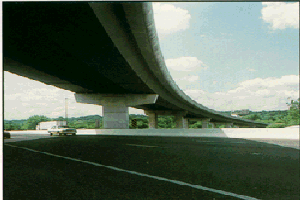Design of Curved Box Girder Bridge System
Downloads
Abstract
The computer program DESCUS II will perform the complete analysis of a horizontally curved bridge composed of steel box sections which act either compositely or noncompositely with a concrete deck. The program can use either the Working Stress Design (WSD) method, the Load Factor Design (LFD) method or the Load and Resistance Factor Design (LRFD) method. The bridge may be of arbitrary plan configuration and can be continuous and skewed over supports. The box girders may have a high degree of curvature and may be nonconcentric.
Program Scope
The program models the bridge structure as a two-dimensional grid in a stiffness format with three degrees-of-freedom at each nodal point (correspoding to torsion, shear, and bending moment). All nodal locations, member connectivities, and properties are generated internally from basic input. All dead load (DL) computations are performed automatically within the program to satisfy the construction conditions specified by AASHTO. Additional dead load (DL) and superimposed dead load (SDL) are allowed to input to combine with the program-generated dead load. All live load (LL) computations also are performed automatically where the AASHTO truck and lane loadings are applied to an influence surface previously generated for the entire bridge.
Output contains the positive and negative maximum moments, shears, reactions, and torsion along with the corresponding primary and warping stresses for each girder and beam or box diaphragm element. These maxima are given along with all AASHTO group combinations for DL + LL + 1. Also output are deformations along each girder for DL and maximum LL + 1. Various tables are output which yield information on the design of the sections including stresses and shear ranges. Finally, tables for bottom flange allowable normal stresses with actual torsional shear stress based on AASHTO Guide Specifications of Working Stress Design and Load Factor Design are included to assist in the design of bottom flanges.
The program has been upgraded to run under the WINDOWS XP/7/8 environments. Single user or Network versions are available.
